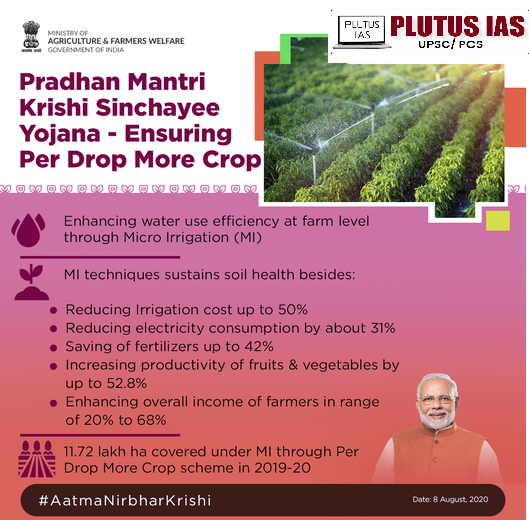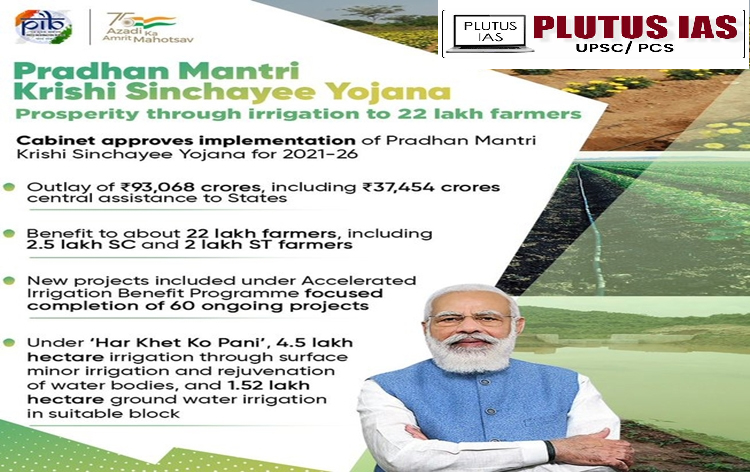Why In the News?
Pradhan Mantri Krishi Sinchayee Yojana(PMKSY) was approved by the Cabinet Committee on Economic Affairs (CCEA) with the motto of “Har Khet Ko Pani.” It is being implemented to expand cultivated areas with assured irrigation, reduce wastage of water and improve water use efficiency.
Programme Components PMKSY:
1. Accelerated Irrigation Benefit Programme (AIBP): A flagship initiative providing financial support for irrigation projects to enhance infrastructure and water supply.
2. Har Khet Ko Paani (HKKP): Aims to expand cultivable areas under assured irrigation, funded through the Command Area Development & Water Management (CADWM) programme, implemented by state departments.
3. Watershed Development: Focuses on effective management of runoff water and soil moisture conservation through activities like ridge area treatment, drainage line treatment, rainwater harvesting, and in-situ moisture conservation.
4. Per Drop – More Crop (Micro Irrigation): Emphasizes maximizing water use efficiency at the farm level, promoting micro-irrigation techniques such as drip and sprinkler systems.
5. Supplementary Water Management Activities (SWMA): Involves farm-level secondary storage structures to support water management and enhance irrigation efficiency.
| Component of PMKSY |
Central assistance (CA) released during 2016-23 (Rs. in crore) |
| Accelerated Irrigation Benefit Programme with pari passu implementation of Command Area Development & Water Management |
18,727.78 |
| Har Khet Ko Pani – Surface Minor Irrigation and Repair, Renovation and Restoration of water bodies |
4,010.32 |
| Har Khet Ko Pani – Ground Water Development |
764.89 |
| Per Drop More Crop |
16,688.71 |
| Watershed Development |
9,559.07 |
| Total |
49,750.77 |

Key Features of PMKSY:
1. Irrigation Infrastructure Development:Focuses on creating and upgrading irrigation facilities, including constructing canals, pipelines, and water storage systems to enhance water accessibility.
2. Micro-Irrigation: Promotes drip and sprinkler irrigation to maximize water efficiency and minimize wastage, supporting sustainable farming practices.
3. Water Conservation:Emphasizes rainwater harvesting and watershed development to ensure sustainable water usage and promote environmental stewardship.
4. Farmer Participation: Encourages active involvement of farmers in planning and implementation processes, ensuring that their needs and local conditions are prioritized.
5. Integrated Approach: Aims to synergize with other government schemes, enhancing agricultural productivity and improving farmer livelihoods through holistic support.
6. Use of Technology: Incorporates modern technologies, such as remote sensing and GIS mapping, to assess irrigation needs and monitor water resources effectively.
7. Focus on Drought-Prone Areas: Targets regions vulnerable to drought, implementing tailored strategies for improved water management and irrigation.

Significance of PMKSY:
1. Increased Crop Productivity: Improved irrigation facilities lead to higher crop yields, contributing to farmer income and food security.
2. Sustainable Practices: Promotes water conservation and sustainable farming practices, crucial for environmental sustainability.
3. Economic Development: By empowering farmers, the scheme contributes to rural economic growth and poverty alleviation.
4. Climate Resilience: Enhances farmers’ ability to cope with the impacts of climate change through better water management.
5. Enhanced Food Security: Increases crop yields and resource management, crucial for mitigating hunger and malnutrition for the growing population.
6. Rural Employment Generation: Develops irrigation infrastructure, creating job opportunities and enhancing skill development in rural communities.
7. Promotion of Technological Adoption: Encourages modern irrigation methods, fostering agricultural innovation and improving competitiveness in the sector.
Challenges of PMKSY:
1. Implementation Issues: Delays in project execution and bureaucratic hurdles hinder timely progress and effectiveness.
2. Awareness and Training: Many farmers lack knowledge of efficient irrigation techniques, limiting the adoption of modern practices.
3. Funding Constraints: Limited financial resources restrict the scale and outreach of PMKSY initiatives, affecting overall impact.
4. Geographical Disparities: Diverse regional challenges require tailored approaches, making a uniform strategy less effective.
5. Technical Infrastructure: Insufficient technical support and maintenance for irrigation systems can lead to inefficiencies and breakdowns.
6. Data Gaps: Lack of accurate data on water resources and agricultural needs complicates planning and implementation.
7. Climate Change Impact: Increasing variability in weather patterns poses additional challenges for irrigation planning and water management.
8. Farmer Resistance: Some farmers may hesitate to adopt new technologies due to traditional practices or scepticism about benefits.







No Comments